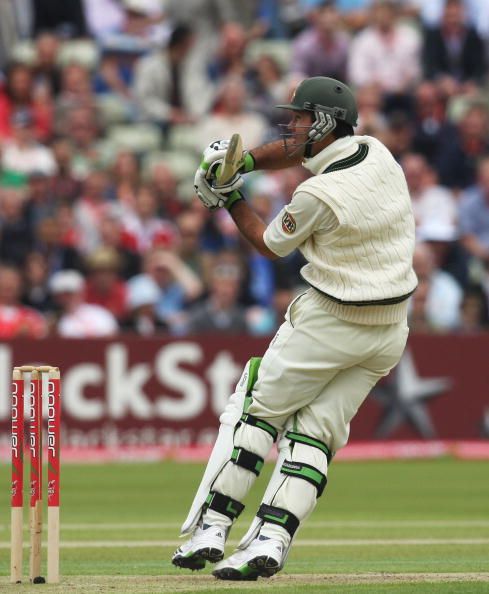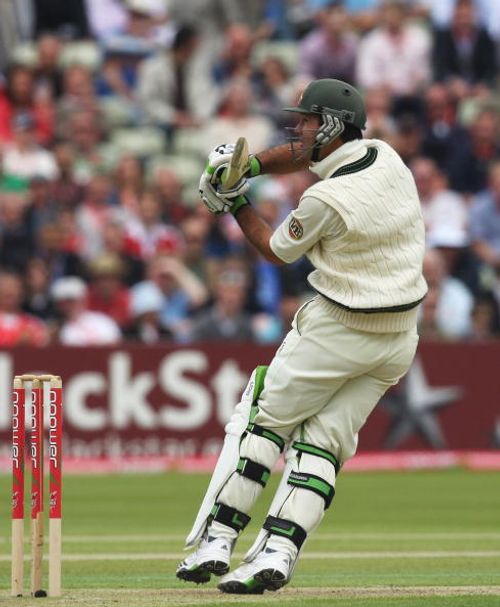
The hook shot in cricket: aggression thus answered

Ricky Ponting playing the hook shot
It is an absolute treat for cricket aficionados when the aggression of the bowlers is neatly complemented by that of the batsmen. Not only does this ensure a ruthless contest where neither side is prepared to lose ground, but also enriches the dexterous rivalry for which the game is celebrated.
The short delivery has been the pet weapon for the bowlers since time immemorial. It has been that faithful servant who would prove to be efficient almost regardless of circumstances and who would yield results more often than not.
A hard cherry gliding through the air at a breakneck speed isn’t a particularly welcoming sight when one is at the receiving end. The aroma of leather that entices fast bowlers is the same that ruffles up the feathers of the batsmen.
While evading the death knell associated with the ominous phrase – chin music – is a far safer option, there have been quite a few cricketers who have failed to restrain themselves from answering back. Aggression, it is said, is best answered with aggression. Thus, was invented the hook shot.
While the cover drive may enjoy the status of graceful elegance and aristocratic sophistication, the hook remains an epitome of savage intentions and vengeful belligerence in the face of murderous instincts of the cherry.
In the days when soldiers on the cricket field had little protection on their heads, the application of the hook was looked upon as being akin to sacrilege against the wrath of the pacers and the batsman was doomed to be condemned by Karma in the disguise of the Kookaburra.
The gamble behind the hook far exceeded the limit of the most perilous risk that the batsman could afford. When it came off, there would be no sight as marvelous, but when it didn’t there would be nothing as regrettable. The tragedy of witnessing David Hookes getting floored by an immaculate bouncer by Andy Roberts could be well accounted as action of Karma.
However, the breathtaking prospect of the missile hitting the deck with brute force and a calculated swivel of the willow dispatching it to the fence or to the stands via an aerial route is too alluring to resist. It wasn’t, therefore, surprising when adventurous batsmen resorted to the most dangerous shot in cricket even without protective gear on their heads.
The defiant nature of the hook echoes the rebel lurking in the heart of the batsman who has been cornered by the opposition on all fronts. The valor behind the hook establishes the fearlessness and audacity of the batsman against the bowler’s imposing will. It is as much an emblem of confronting arrogance as of determined dominance.
The destructive instincts essential for the flawless execution of the hook can be self explained by the names of some of the masters of the trade – Kim Hughes, Viv Richards, Gordon Greenidge, Gary Sobers, Richie Richardson, Ian Chappell, Mohinder Amarnath, and Ricky Ponting.
However, despite the fact that the hook shot relies more on brute power than subtle finesse, some of the cricketers have successfully injected an element of art into the manifestation of raw aggression.
Ricky Ponting’s trademark swing of the willow while leaning precariously to the right stands as a glorious example of creative balancing. On the same note, it was a delight to watch Ian Botham hooking reflexively so late off his forehead that one always tipped on the edge of anxiety that he would damage his eyes.
Given the prevalent fearlessness in the days without helmet, the reluctance of today’s hookers with heavy protective gear is apparently unfathomable. However, the analysis becomes particularly revealing when one digs into the logistics.
The hook can, undoubtedly, be called a ‘rash shot’. Cricket has evolved rapidly through the years and the modern version of the game calls for calculated risks more than naive gambles.
While the hook may yield a boundary or an over-boundary at its best, the prospects of getting a nick to the wicket-keeper or a mistimed loop to deep fine leg looms large on the executor. Further, if it fails to connect, a piece of leather ramming into the grills inches away from your eyes, or perhaps kissing your nasal ridge isn’t a spectacle of amusement.
The restriction of bouncers per over by the ICC translates as fewer short deliveries and consequently, fewer hooks. Meanwhile, the persisting problem of batsmen against short-pitched stuff across the world implies declining number of exponents of majestic bravado.
The hookers, today, are an endangered species who are bound to perish under the stringent policies of the ICC if their regular fodder continues to be flat pitches with mediocre bounce. With the thrill of the skills diminishing, the technological progress of cricket remains an irony.